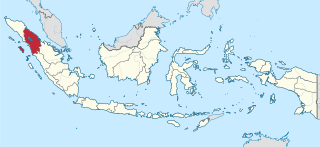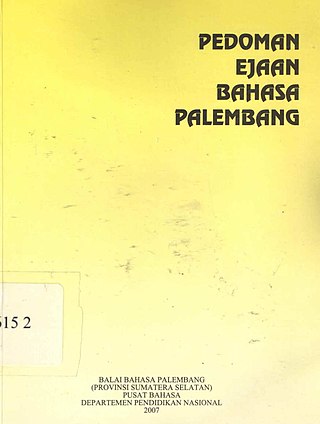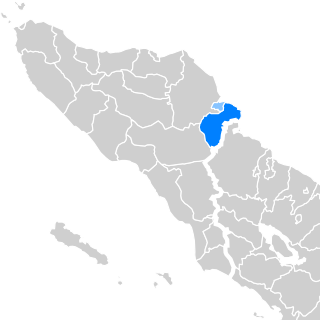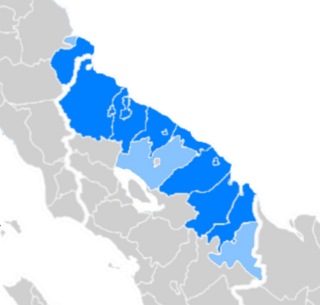
Malay is an Austronesian language that is an official language of Brunei, Indonesia, Malaysia, and Singapore, and that is also spoken in East Timor and parts of Thailand. Altogether, it is spoken by 290 million people across Maritime Southeast Asia.

Medan is the capital and largest city of the Indonesian province of North Sumatra. The nearby Strait of Malacca, Port of Belawan, and Kualanamu International Airport make Medan a regional hub and multicultural metropolis, acting as a financial centre for Sumatra and a gateway to the western part of Indonesia. About 60% of the economy in North Sumatra is backed by trading, agriculture, and processing industries, including exports from its 4 million acres of palm oil plantations. The National Development Planning Agency listed Medan as one of the four main central cities in Indonesia, alongside Jakarta, Surabaya, and Makassar. In terms of population, it is the most populous city in Indonesia outside of the island of Java. Its population as of 2023 is approximately equal to the country of Moldova.

Minangkabau is an Austronesian language spoken by the Minangkabau of West Sumatra, the western part of Riau, South Aceh Regency, the northern part of Bengkulu and Jambi, also in several cities throughout Indonesia by migrated Minangkabau. The language is also a lingua franca along the western coastal region of the province of North Sumatra, and is even used in parts of Aceh, where the language is called Aneuk Jamee.

North Sumatra, also called North Sumatra Province, is a province of Indonesia located in the northern part of the island of Sumatra, just south of Aceh. Its capital and largest city is Medan on the east coast of the island. It is bordered by Aceh on the northwest and Riau and West Sumatra on the southeast, by coastlines located on the Indian Ocean to the west, and by the Strait of Malacca to the east.
In addition to its classical and modern literary form, Malay had various regional dialects established after the rise of the Srivijaya empire in Sumatra, Indonesia. Also, Malay spread through interethnic contact and trade across the south East Asia Archipelago as far as the Philippines. That contact resulted in a lingua franca that was called Bazaar Malay or low Malay and in Malay Melayu Pasar. It is generally believed that Bazaar Malay was a pidgin, influenced by contact among Malay, Hokkien, Portuguese, and Dutch traders.

Haji Tengku Rizal Nurdin was the 13th Governor of North Sumatra, Indonesia. He served from 1998 until his death on 5 September 2005. In that time he was serving in his second period (2003–2008). In the previous period (1998–2003), he was also the Governor of North Sumatra.

Jambi Malay, is a Malayic language primarily spoken by the Jambi Malay people in Jambi, Indonesia, but also spoken by migrants who have settled in Jambi. Jambi Malay is considered as a dialect of the Malay language that is mainly spoken in Jambi, but it is also used in the southern part of Riau and the northern part of South Sumatra. In Jambi, Jambi Malay has eight dialects, including the Tanjung Jabung dialect, Jambi City dialect, Muaro Jambi dialect, Batanghari dialect, Tebo dialect, Bungo dialect, Sarolangun dialect, and Merangin dialect. Jambi Malay is used as a lingua franca and for interaction among the various ethnic groups in Jambi. The differences between each dialect in Jambi Malay range from about 51 to 80 percent.

The Malayic languages are a branch of the Malayo-Polynesian subgroup of the Austronesian language family. The most prominent member is Malay, a pluricentric language given national status in Brunei and Singapore while also the basis for national standards Malaysian in Malaysia and Indonesian in Indonesia. The Malayic branch also includes local languages spoken by ethnic Malays, further several languages spoken by various other ethnic groups of Sumatra, Indonesia and Borneo even as far as Urak Lawoi in the southwestern coast of Thailand.

The Sultanate of Deli was a 1,820 km² Malay state in east Sumatra founded in 1630. A tributary kingdom from 1630 it was controlled by various Sultanates until 1814, when it became an independent sultanate and broke away from the Sultanate of Siak.

Kedah Malay or Kedahan or as it is known in Thailand, Syburi Malay is a Malayic language mainly spoken in the northwestern Malaysian states of Perlis, Kedah, Penang, and northern Perak and in the southern Thai provinces of Trang and Satun. The usage of Kedah Malay was historically prevalent in southwestern Thailand before being superseded by the Thai language. Enclaves of Kedah Malay can be found in Kawthaung District in Myanmar; Ranong and Krabi in upper southern Thailand; Jaring Halus, Langkat and Aceh in Sumatra, Indonesia and up north in Bangkok, central Thailand, where most of the Kedah Malay speakers are descendants of historical settlers from Kedah.

Malay Indonesians are ethnic Malays living throughout Indonesia. They are one of the indigenous peoples of the country. Indonesian, the national language of Indonesia, is a standardized form of Riau Malay. There were numerous kingdoms associated with the Indonesian Malays along with other ethnicities in what is now Indonesia, mainly on the islands of Borneo and Sumatra. These included Srivijaya, the Melayu Kingdom, Dharmasraya, the Sultanate of Deli, the Sultanate of Siak Sri Indrapura, the Riau-Lingga Sultanate, the Sultanate of Bulungan, Pontianak Sultanate, and the Sultanate of Sambas. The 2010 census states that there are 8 million Malays in Indonesia; this number comes from the classification of Malays in East Sumatra and the coast of Kalimantan which is recognized by the Indonesian government. This classification is different from the Malaysia and Singapore census which includes all ethnic Muslims from the Indonesian archipelago as Malays.

Kedahan Malays or commonly known as Orang Utara ('Northerners'), are a sub-group of Malays native to northern Malay Peninsula in areas of both current and historical area of Kedah. They are among the oldest ethnic groups in the Malay peninsula with a history dating back 2,800 years as proven by the discovery of sites in Bujang Valley and historical documents from India, China and Arabia. Kedahan Malays are one of the largest Malay sub-groups in Malaysia, comprising at least 15% of the total Malaysian Malay population including those with Kedahan ancestry.

Palembang, also known as Palembang Malay, is a Malayic variety of the Musi dialect chain primarily spoken in the city of Palembang and nearby lowlands, and also as a lingua franca throughout South Sumatra. Since parts of the region used to be under direct Javanese rule for quite a long time, Palembang is significantly influenced by Javanese, down to its core vocabularies.

Bangka or Bangka Malay, is a Malayic language spoken in Indonesia, specifically on the island of Bangka in the Bangka Belitung Islands of Sumatra. It is primarily spoken by the native Malay people of Bangka, as well as by immigrants from other parts of Indonesia and the Bangka Chinese, who use it as their second language in addition to their native Hakka. Bangka Malay is spoken exclusively on the island of Bangka, although it is related to Palembang Malay and Belitung Malay spoken on neighboring islands. There are five different dialects of Bangka Malay: the Pangkalpinang dialect, Mentok dialect, Belinyu dialect, Sungailiat dialect, and Toboali dialect. Each of these dialects has its own subdialects. Additionally, the Bangka Chinese community speaks their own dialect of Bangka Malay, which is influenced by Hakka. The differences between each of these dialects are mostly lies in their phonology and morphology, except for the Bangka Cina dialect, which also has slight differences in vocabulary.
Pakpak, or Batak Dairi, is an Austronesian language of Sumatra. It is spoken in Dairi Regency, Pakpak Bharat Regency, Parlilitan district of Humbang Hasundutan Regency, Manduamas district of Central Tapanuli Regency, and Subulussalam and Aceh Singkil Regency.
Tuanku Sri Paduka Gocah Pahlawan also known as Muhammad Dalik according to Hikayat Deli, was the founder of the Sultanate of Deli and the Sultanate of Serdang in North Sumatra, Indonesia. According to the tarombo from Deli and Serdang, Gocah Pahlawan was of keling (Indian) ethnicity, sent by Sultan Iskandar Muda in 1612 to rule in the former Aru Kingdom. He was appointed as a representative commander of the Aceh Sultanate for the area, to fight the Portuguese influence and establish alliances with the local population, who generally were Karo peoples.
Damiri Mahmud was an Indonesian writer. He also wrote poetry and various articles for newspapers and magazines. His writings in the form of cultural, political, and religious articles, appeared in various dailies and magazines in Indonesia and Malaysia, among others: Buana News, Pelita, Kompas, Republika, People's Thoughts, Analysis, Alert, Free, People's Mind, Lampung Post, Media Indonesia, Community Flag, Sovereign, Horison, Base, Council for Literature and Daily News (Malaysia).
The 1998 North Sumatra gubernatorial election was an indirect election held to elect the Governor of North Sumatra for the 1998–2003 term. All members of the Regional People's Representative Council of North Sumatra were eligible to vote for this election.
Tuanku Panglima Paderap, also called Panglima Deli, was the third ruler of the Deli Sultanate, now part of North Sumatra, Indonesia. He succeeded his father Tuanku Panglima Perunggit, who died around 1700. Paderap had four sons, namely Tuanku Jalaluddin, Tuanku Panglima Pasutan, Tuanku Tawar, and Tuanku Umar.

Tamiang Malay, is a Malayic language spoken in Indonesia, specifically in the Aceh Tamiang and significant minorities in Langsa on southeastern Aceh, bordering North Sumatra. It is primarily spoken by the native Malay people of Tamiang. Tamiang Malay is significantly different from Acehnese, the dominant language in Aceh, and they are mutually unintelligible. Instead, Tamiang Malay shows similarities to Langkat Malay and Deli Malay spoken in neighboring North Sumatra. Additionally, Tamiang Malay has been influenced by other languages, such as Acehnese and Gayonese, forming a distinct Malay dialect unique to the region. Tamiang Malay plays a significant role in the daily lives of the Tamiang community. For example, traditional ceremonies, community activities, and other social interactions are conducted in Tamiang Malay. Additionally, for the Tamiang people, Tamiang Malay is considered as a symbol of pride and a distinct regional identity. Most Tamiang people are proficient in Acehnese and Indonesian, in addition to their mother tongue.














